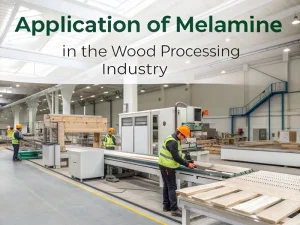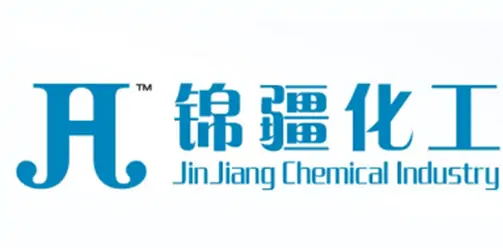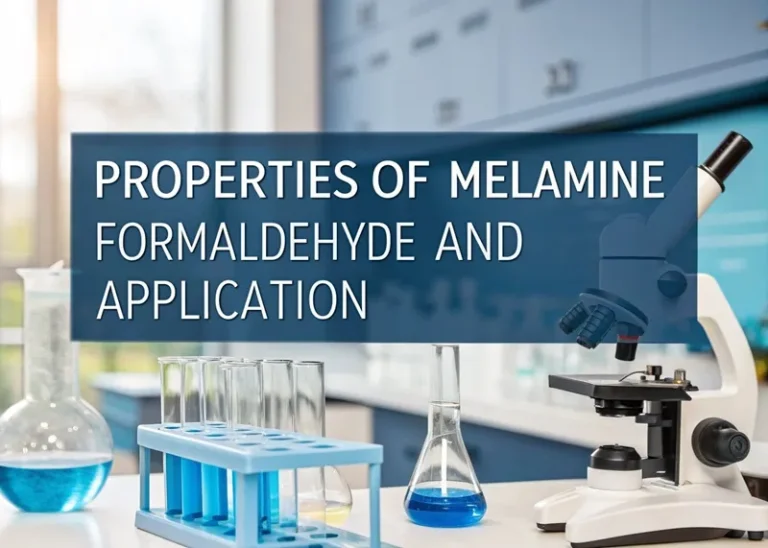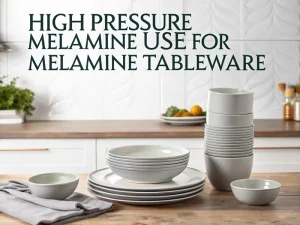
Application Of Melamine In The Wood Processing Industry
Tech Blog Application of Melamine in the Wood Processing Industry Melamine powder is widely used in the wood processing industry, including melamine-impregnated film paper, wood


Melamine formaldehyde (MF) resin is a thermosetting polymer synthesized by reacting melamine (C₃H₆N₆) with formaldehyde under controlled conditions. The reaction forms a highly cross-linked network of methylene and methyl ether bridges, creating a rigid, three-dimensional structure. Key synthesis parameters include:
Catalyst Type: Alkaline catalysts like triethylamine enhance hydroxymethylation but may increase side reactions, improving thermal decomposition resistance1.
Molar Ratios: Optimal ratios (e.g., 1:7:2 for melamine, formaldehyde, and n-dodecanol) ensure balanced polymerization for applications like microencapsulation.
Physical Properties
Density: ~1.5 g/cm³, making it lightweight yet durable.
Surface Hardness: Scratch-resistant, ideal for laminates and tabletops.
Water Resistance: Non-porous surface repels moisture, suitable for humid environments.
Thermal Stability
MF resin withstands temperatures up to 160°C without deformation. Prolonged heating above this threshold releases formaldehyde, but additives like boron or silica can mitigate degradation.
The thermal expansion coefficient of Mf resin is relatively low. This means that it will not significantly expand or contract with temperature changes.
Chemical Properties
Chemical Resistance: Resists acids, alkalis, and organic solvents, though strong acids/alkalis may degrade the structure.
Stability: The cross-linking structure of melamine formaldehyde gives it high chemical stability. Under normal environmental conditions, it is not easily decomposed.
Flame Retardancy: Releases nitrogen gas when heated, reducing flammability in textiles and composites
Mechanical Properties
Mechanical Strength: High tensile strength (e.g., Young’s modulus up to 2.3 GPa) due to cross-linked networks.
Impact Resistance: Although it is a hard material, melamine formaldehyde also has some impact resistance. It can absorb a certain amount of impact energy without breaking.
Melamine formaldehyde has become a popular choice for tableware due to its excellent performance. Heat resistance enables it to handle hot food and beverages, making it suitable for supplying a variety of foods. Its high hardness and scratch resistance ensure that plates, bowls, and tableware can withstand the harsh tests of daily use without being easily damaged. Nonporous surfaces are not only easy to clean but also prevent the absorption of food odors and stains.
In addition, its ability to be easily molded into various shapes and colors also contributes to its widespread use in tableware production, as it can meet different aesthetic preferences.
In the plywood industry, melamine formaldehyde plays a crucial role. It is often used as a coating material for plywood. The hard and durable properties of melamine formaldehyde resin form a protective layer on the surface of plywood. This coating significantly improves the resistance of plywood to scratches, moisture, and chemicals.
It can mimic the appearance of natural wood grain or solid color, enhancing the aesthetic appeal of plywood. In addition, the cross-linked structure of melamine formaldehyde has excellent adhesion to plywood substrates, ensuring that the coating remains intact over time. Melamine-coated plywood can improve performance and lifespan in furniture manufacturing, interior decoration, or construction.
Concrete Superplasticizers: MF-based additives improve workability and reduce water content in concrete, enhancing compressive strength.
Oxygen Barrier Films: Crosslinked MF-polyvinyl alcohol (PVA) composites reduce oxygen transmission rates by 99%, ideal for food packaging.
Phase Change Materials (PCMs): MF shells encapsulate oils or paraffin for thermal energy storage in textiles, achieving enthalpy values up to 166 J/g.
Self-Healing Composites: MF microcapsules release healing agents (e.g., epoxy) upon damage, extending material lifespan.
Mesoporous MF Polymers: Solvent-assisted curing creates high-surface-area materials for CO₂ adsorption (up to 1.0 cm³/m²/day).
Bio-Based Modifications: Hybrid MF resins with lignin or cellulose nanocrystals improve biodegradability.
Formaldehyde Emissions: Low-quality MF resins may release volatile organic compounds (VOCs). Opt for E1/E0-certified products to meet safety standards.
Recyclability: Traditional MF is non-recyclable, but research focuses on bio-degradable variants and closed-loop production systems.
Melamine formaldehyde resin’s unique blend of thermal stability, mechanical strength, and chemical resistance makes it indispensable across industries. While challenges like formaldehyde emissions persist, advancements in eco-friendly formulations and smart manufacturing are paving the way for safer, sustainable applications.
For industries prioritizing durability and innovation, MF resin remains a cornerstone material.

Tech Blog Application of Melamine in the Wood Processing Industry Melamine powder is widely used in the wood processing industry, including melamine-impregnated film paper, wood

Tech Blog High Pressure melamine Use For Melamine Tableware Melamine tableware has become a staple for households, restaurants, and catering services worldwide due to its

Tech Blog Melamine packaging For manufacturers, inaccurate packaging not only fails to meet national standards but also increases labor costs and the risk of product

JINGJIANG MELAMINE POWDER
© JINJIANG MELAMINE